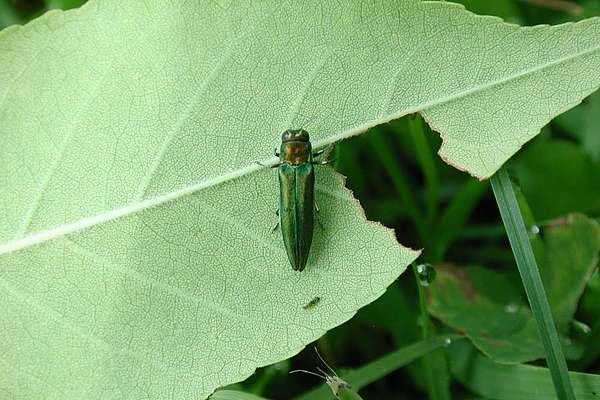Taken from Vermont Invasives, February 28, 2018
Emerald ash borer has been confirmed in northern Orange County. This is the first emerald ash borer (EAB) infestation discovered in Vermont. Forestry crews have been dispatched to the area to determine the extent of the infestation. Here is a map of EAB infestations in New England.
Emerald ash borer was first discovered in the Detroit, Michigan area in 2002, though it is believed to have arrived in the 1990’s. EAB is now known to be established in 32 states and three Canadian provinces. The beetle is about one half an inch and metallic green. Its larvae tunnel through the wood just under the bark of ash trees; killing the tree by cutting off the flow of nutrients. Healthy ash trees can die within 1-4 years of showing their first sign or symptom. All species of ash trees are susceptible.
What threat does the emerald ash borer pose to Vermont?
5% of Vermont's trees are ash. The majority of ash trees infested with emerald ash borer will die. The emerald ash borer poses a threat to Vermont's economy and ecology. It spreads very quickly, is difficult to detect, and eradication is not expected.
The emerald ash borer will impact Vermont municipalities. Dead trees may become a public hazard and a liability to the town. Planning ahead can mitigate the impact and financial burden of responding to infestations. The state has assistance available for preparedness planning.
What is Vermont doing to respond to this invasive insect?
Federal and state agencies have been working with UVM, industry, and volunteer groups. A response plan is in place and being implemented in a coordinated, collaborative way.
Delineation surveys are being carried out. These surveys will indicate whether an in-state quarantine would help protect our ash trees.
Where can I learn more about the emerald ash borer?
Visit Vermont Invasives emerald ash borer invader page for more information on identification, signs and symptoms, and biology.
Visit firewood.vt.gov for more information on how the movement of firewood can spread invasive insects like the emerald ash borer.
What should I do with ash trees on my property?
Don't panic & don't follow advice to cut all your ash trees right now. There is time to learn and to act when the time is right. For information about what to do with your ash trees, contact your county forester.
Several studies conducted by Michigan State University and USDA Forest Service scientists have shown that EAB beetles are attracted to stressed ash trees. Intentionally girdling trees is a method used for EAB detection. This guide explains how, as a Vermont landowner, you can use trap trees to detect the emerald ash borer.
What can I do to help?
- Look for signs and symptoms of the emerald ash borer (visit vtinvasives.org/eab for a slideshow of images).
- Report suspicious findings on VTinvasives.org.
- Buy your firewood where you burn it and encourage others to do the same. Don't move firwood!
Questions? Contact Lamoille County Forester, Rick Dyer, at 802-888-5733 x406 or rick.dyer@vermont.gov For more information, visit vtinvasives.org/eab
